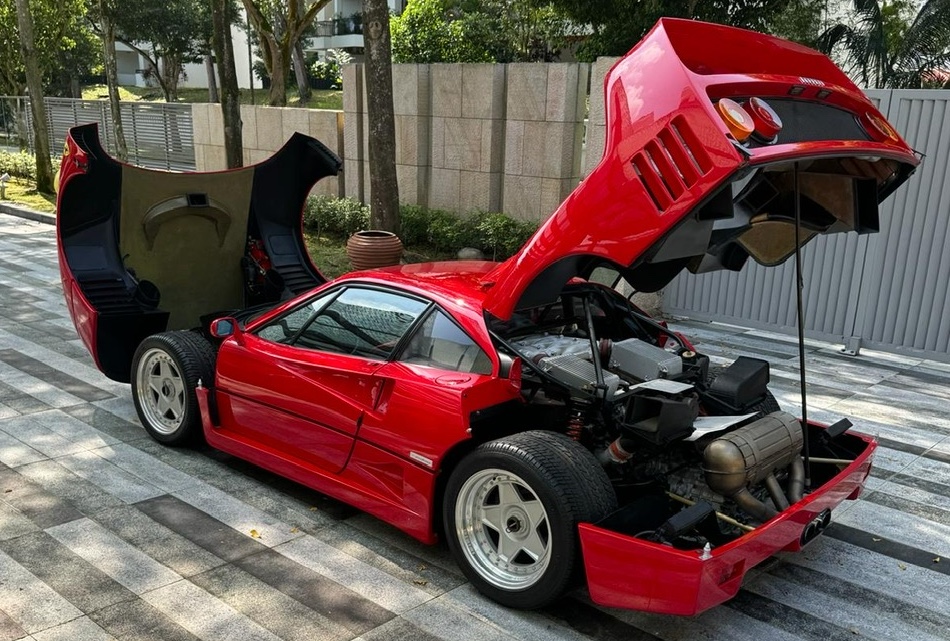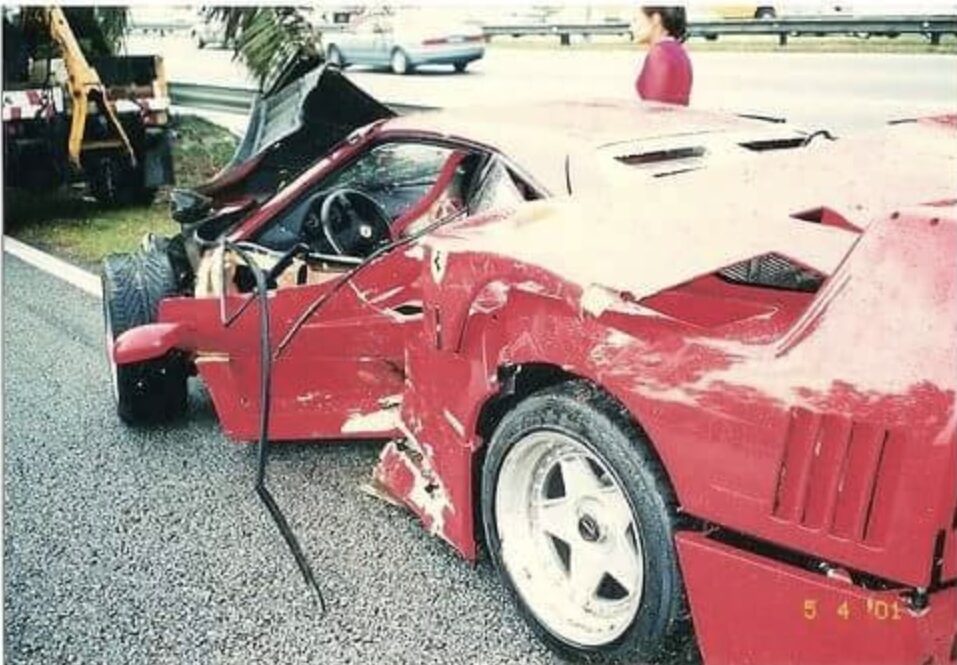We start with insane import duties and onerous regulations.
Ferrari never made a RHD 288 GTO, F40, F50 or Enzo, (excluding a few dozen built by Pininfarina for the Brunei Royal Family) and so none of these Supercars, either new or used, were registered in most Asian countries, (excluding Japan), as almost all Asian countries are RHD, no LHD allowed! And if a RHD car could be registered, the costs are eye watering. In Hong Kong, for instance, the tax is 46% of value on the first $150,000 HK Dollars (about $19,000 US dollars); 86% on the next $150,000 HKD; 115% on the next $200,000 HKD (about $25,500 USD) and 132% on the rest, so the HK Duty on a $2.5m F40 is about $3.3m USD, substantially more than the actual $2.5m purchase price, and then only if that car could indeed be registered!
Thailand keeps their rule simple, the private import of new/used cars is not permitted while in Malaysia private import is possible but extremely difficult and expensive, starting with an Approved Permit (AP) which has to be purchased (at considerable expense) from a Malaysian Car dealer. The Import duty is calculated on the engine
capacity and the duty on a foreign car over 3 liters is 300%….this is why many brands assemble cars in ASEAN countries such as Malaysia or Thailand to achieve lower duty…
As for Singapore, newer imports must be, at most, three years old and classic cars must be thirty-five years old or older, and, of course, only if they are RHD! Additionally, Singapore has a 10-year “certificate of entitlement” (COE) system to control the number of cars in the small city-state. The COE gives the owner the right to register and use a vehicle in Singapore for 10 years and can only be obtained through an online open auction conducted twice a month. The total number of cars that can registered is capped at 950,000 so the only way to win a COE is for another car to be de-registered. And if the potential buyer should win an auction, the cost of the COE will almost certainly be well north of $100k USD plus a 20% import tax, a 7% GST and a host of lesser fees. And, again, only if the car is RHD and meets the age criteria.
Ready to ride with no place to go
Hong Kong is connected to the mainland by the Kowloon peninsula and includes over 200 islands, with 7.5m people crammed into 1104 sq miles. Singapore consists of 63 islands and islets with 5m people crammed in 283.9 sq miles, making both among the top five most congested countries on the planet. Because of their similar geography, there’s basically nowhere to go and the speed limit in Hong Kong is 50kph in most areas with a maximum of 110kph in a few short areas. The speed limit in Singapore is 50kph in town and 80 to 90 kph on the few short expressway.
As an interesting aside, the ultra-wealthy in Hong Kong, Singapore and other countries are avid exotic car collectors with substantial collections of Supercars on static display, in climate controlled and very private collections. All were purchased as both pride-of-ownership trophies and long-term investments that were entered into their respective country and never driven or registered, so tax-free. An offer of any of these Supercars, out of Asia, that are now twenty to thirty-eight years old, with no or ultra-low miles, is not unusual.
Anoraks fill in the blanks

Our story begins in early February of this year when a three car package, included an F40, an F50 and an Enzo, all described as all-original, no-stories cars, each with under 400 kms, was offered out of south East Asian. Priced at $12m USD, there was immediate interest from regional dealers in Australia and Hong Kong. Word spread quickly and interest came in from dealers worldwide. After multiple requests for more information and the serial or chassis numbers of each car it was confirmed that the cars were F40 s/n 87344, F50 s/n 106410 and Enzo s/n 92788.
As long term readers of these columns know, there is a small world of serial number trackers or “anoraks”, with an obsessive-compulsive hobby that includes tracking and recording incredibly detailed information on arcane subjects, such as trains, or cars, or airplanes, or luxury yachts, most of which is normally regarded as more than staggeringly boring by the rest of the population. This author is one of those Ferrari-tracking anoraks.
A quick walk through our database and a few e-mails to fellow anoraks determined that these three Ferraris are actually owned by a Singapore entrepreneur. He owns an extensive car collection that includes F40 s/n 87344, F50 s/n 106410 and Enzo s/n 92788 plus a Lamborghini Murciélago, a Bugatti Veyron, a Pagani Zonda, a McLaren MP4-12C, a Lamborghini Aventador and more. Most are not registered or driven, merely trophies.
We begin with Enzo s/n 92788

2004 Enzo s/n 92788 is interesting in that the s/n is far outside the range of Enzo s/ns and almost 36,000 s/ns before s/n 128778, the first Enzo shown to the public on 27-28 June 2002 at the Logistics center at the Fiorano test track. A little homework confirmed that s/n 92788 is one of the super early numbers not used in period and later recycled. Enzo s/n 92788 was sold new to Singapore and apparently has never changed hands, a proper one owner car. Today Enzo s/n 92788 has only 336kms and after sitting for twenty years every gasket and every piece of rubber is long past its due date, the engine and gearbox need to come out for a reseal and every water, heater A/C, oil and fuel hose needs to be replaced, plus the mother of all details, at a cost that will instantly consume a $100,000 bill, or more, probably much more.
And move on to F50 s/n 106410

F50 s/n 106410 was sold new to Albert Chung in Hong Kong, the later sales date to Singapore is unknown, but the mileage, at 078kms, is probably unquestioned because it has only ever been in Hong Kong and Singapore. Ferrari HK has no record of it ever having serviced it and we haven’t found any service records from its Singapore lifetime. F50 s/n 106410 can be classified as unused, but the photos reveal some serious deterioration due to climatic conditions and lack of use, like Enzo s/n 92788 it will need months of work that starts at $100,000 or more, almost certainly much more, to get s/n 106410 to the condition owners expect with a car such low kms.

An F40 with stories
1990 F40 s/n 87344 was new to Graber Automobiles, the authorized dealer for Bern, Switzerland before going to a well known dealer in Munich Germany. In 1991, Nims Dhillon, then the owner of Walnut Creek Ferrari, sold F40 s/n 87344 and two other Euro Model F40s to a silicon valley collector for $400k each. As Euro spec cars they couldn’t be imported into the US, Nims never owned or paid for them so none were ever delivered. The silicon valley collector sued Nims, but Nims left the country and went back to India. In 1992 the Silicon valley buyer tracked down F40 s/n 87344 to the actual owner in Munich but he had no legal right to the car. In 1992 s/n 87344 was sold to Roland Dane of Park Lane Leasing in London, who sold s/n 87344 to a dealer in Malaysia. Our sources show that s/n 87344 was next sold and delivered in 1993 to the son of a high-ranking Malaysian politician and driven from the Singapore border at Johore to Kuala Lumpur, about 400kms. We have found no service records or information on mileage from 1993 until April 2001 when F40 s/n 87344 was crashed into a palm tree on a test drive with the Malaysian owner in the passenger’s seat and a mechanic from the authorized dealer driving. Nothing was done with the wreck, we understand it sat outside the back of the authorized dealer in Kuala Lumpur from 2001 to 2006 before going to Italy for a massive rebuild.
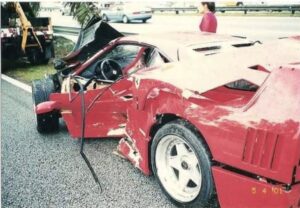
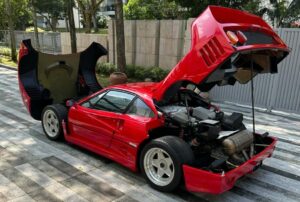
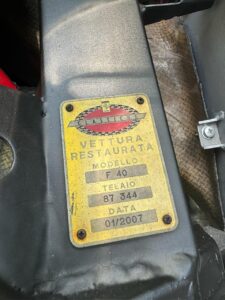
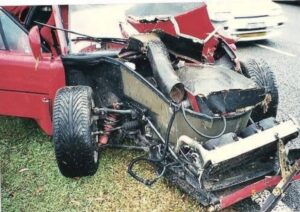
Having owned a large Ferrari-focused body and frame repair shop many years ago, I opine the frame, which was bent like a boomerang, was not repairable. The easiest “repair” would be to jack up the chassis number and slide a new frame underneath. All original F40 chassis were built by Vaccari, a small shop at Via Malta 22 in Modena, who still has all the jigs and patterns to make any early Ferrari Frame. And so the frame was “repaired” by Vaccari and the body and paint were done by Zanazi, the Factories official body shop, with s/n 87344 completed in time for the car to be shown at the 60th Anniversary at Fiorano in June of 2007.
F40 s/n 87344 comes with its Classiche Red Book, which notes the frame repairs by Vaccari on the Telaio (or frame) page and the body repairs by Zanazi on the Carrozzeria (or body) pages. Today F40 shows a very optimistic 161 kms. We assume that when F40 s/n 87344 was rebuilt the odometer was set back to zero. We also assume that the current owner of the F40 probably does not know of the previous damage history and we have an e-mail chain that shows that various brokers offering these cars dismisses that F40 s/n 87344 has some very serious diminution in value issues because of the crash and rebuild. To date, November 2024, there has been no flexibility in price and the crash photos only came to light thanks to fellow anoraks.
And the many morals to the story is…………
Firstly, if you don’t completely understand how to negotiate and conclude a transaction in a (very) foreign country, half a planet away, hire people who do. Hire an expert historian to do their research, a different expert with Supercar service and restoration experience to do an in-person inspection and a local lawyer or law firm that can handled the paperwork (what does a Singapore title look like?) through escrow and payment.
Secondly, American’s just don’t realize how luck we have it with import duty at a mere 2.5%. Yes, California can be problematic and cars less than 25 years have to go through and EPA and DOT or show and display process, but the cost and time needed is rational, relative to current market values.
Thirdly, regardless what the estimate may be to restore the F50 and Enzo, it will cost more and take longer than planned. In all probability, much more and much longer
Last but not least, cars need to be driven, any car living in a what is rain forest, for decades, with zero service records, has multiple levels of problems that will cost hundreds of thousands to resolve. Caveat Emptor.
My thanks (in alphabetical order) to Andy Dayes, Anthony Moody, Bill Orth, David Allison, Giuseppe Tomasetti, Lance Coren, Marc Noodeloos and Nigel Petas for their feedback.

